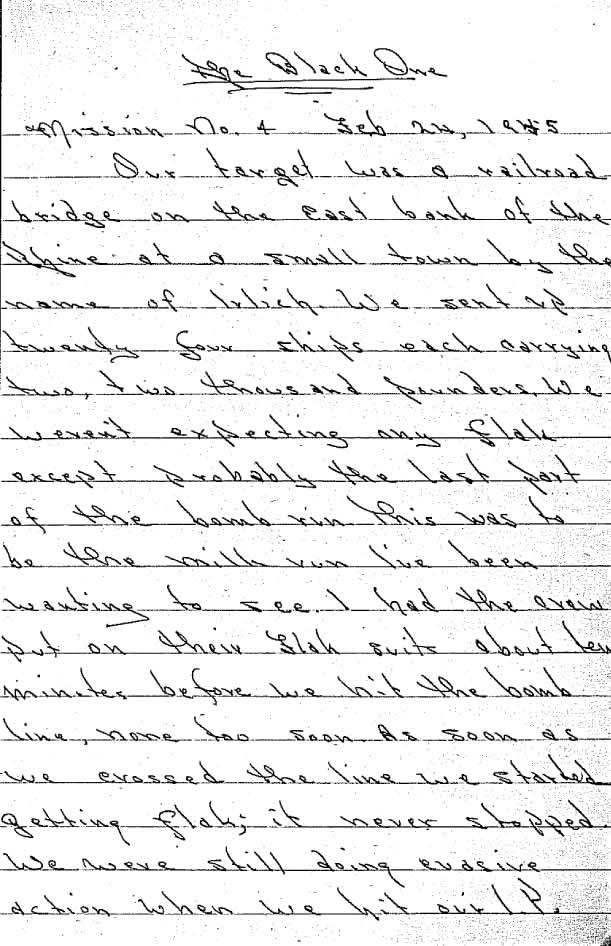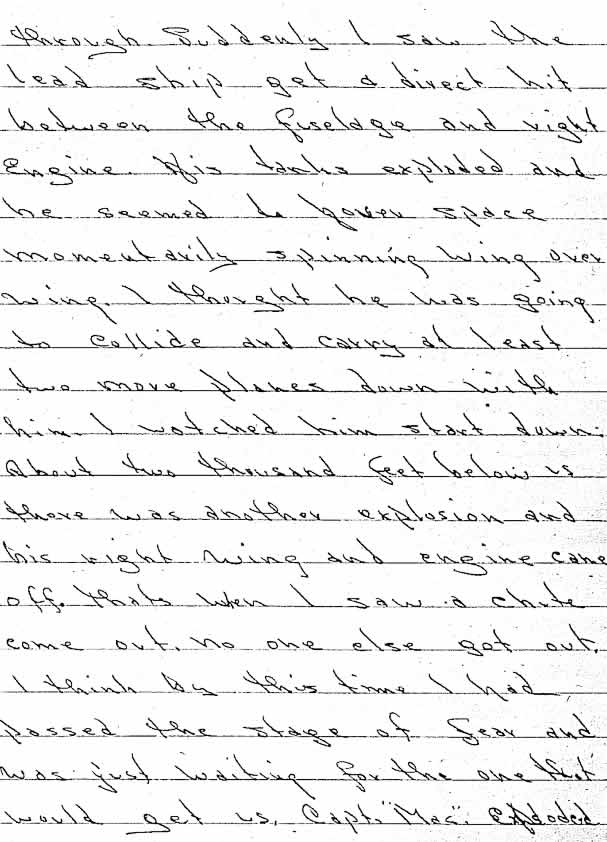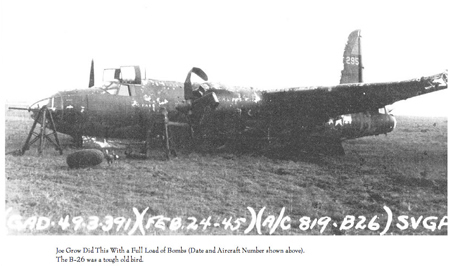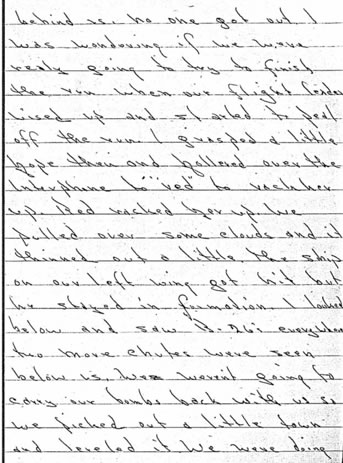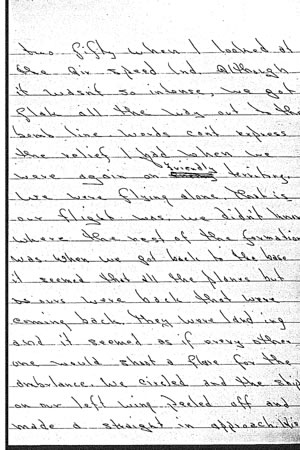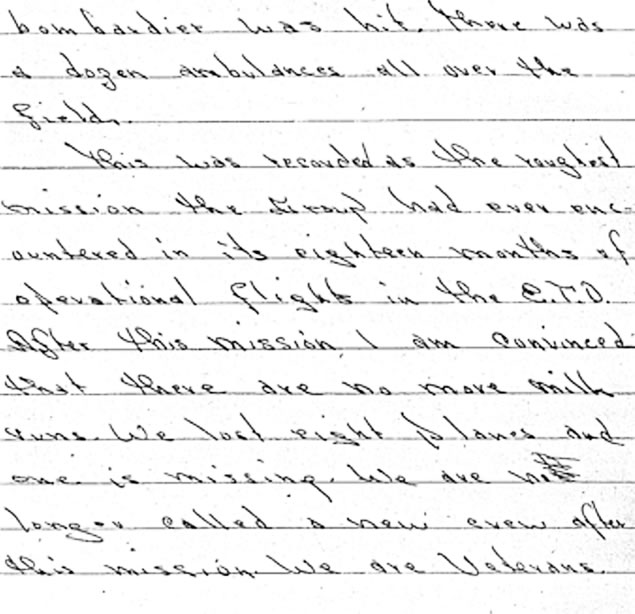The Black One Mission # 4 Feb. 24, 1945 Our target was a railroad bridge on the east bank of the Rhine at a small town by the name of Irlich. We sent up twenty four ships, each carrying two, two thousand pounders. We weren’t expecting any flak, except probably the last part of the bomb run. This was to be the milk run I’ve been wanting to see. I had the crew put on their flak suits about ten minutes before we hit the bombline, none too soon. As soon as we crossed the line we started getting flak; it never stopped. We were still doing evasive action when we hit our I. P. Just before we hit the I. P., I saw six ships coming from the target area. Number five man in that flights right engine was on fire but he was holding her in and after it passed us it seemed to go out. We turned on our bomb run with the bomb bay doors open. The flak was thick and getting thicker. We were the second flight of six ships to go on the run. Flak was everywhere, between our ships. Not only could I hear it bursting but I could see the red flame when it went off. The lead flight was about three quaters of it way when a barrage went up that looked as if a glea couldn’t go theough it. Suddenly I saw the lead ship get a direct hit between the fuselage and the right engine. His tanks exploded and he seemed to hover space momentarily, spinning wing over wing. I thought he was going ot collide and carry at least two more planes down with him. I watched him start down about two thousand feet below us there was another explosion and his right wing and engine came off. That’s when I saw a chute come out. No one else got out. I think by this time I had passed the stage of fear and was just waiting for the one that would get us. Capt. “Mac” exploded behind us. No one got out. I was wondering if we were really going to try to finish the run when our flight [leaders raised?] up and started to peal off the run. I grasped a little hope then and hollered over the interphone to “Red” to rack her up. Red racked her up. We pulled over some clouds and it thinned out a little. The ship on our left wing got hit but he stayed in formation. I looked below and saw B-26’s everywhere, two more chutes were seen below us. We weren’t going to carry our bombs back with us so we picked out a little town and leveled it. We were doing two fifty when I looked a the air speed indicater. Although it wasn’t so intense, we got flak all the way out to the bomb line. Words can’t express the relief I had when we were again on friendly territory. We were flying alone. That is our flight was, we didn’t know where the rest of the formation was. When we got back to the base it seemed that all the planes but ours were back that were coming back. They were landing and it seemed as if every other one would shoot a flare for the ambulance. We circled and the ship on our left wing peeled off and made a straight approach. His bombadier was hit. There was a dozen ambulances all over the field. This was recorded as the **roughest mission the group had ever encountered in it’s eighteen months of operational flight in the E. T. D. [European Theatre?] After this mission, I am convinced that there are no more milk runs. We lost ***eight planes and one is missing, we are no longer called a new crew, after this mission we are Veterans. ________________________________________ ***The Missing Air Crew Report (MACR) report only four from the 391’st on 2/24/45.....So don’t know if I’ve got his group wrong or if the MACR is recorded wrong or incomplete.
** Actually the 391st had a terrible day back in December, but his squadron was off duty that day. 391st Unit Citation . Activated: 21 January 1943 The following citation is quoted from General Order 12 dated 24 February 1945: "The 391st Bombardment (M) is cited for outstanding performance of duty in action, against the enemy from 23 to 26 December 1944. On the morning of 23 December 1944, 30 aircraft of the 391st Bombardment Group (M) were dispatched in an attack upon a railroad viaduct at Ahweiler, Germany. Despite the fact that fighter escort was lacking, and both the Pathfinder aircraft were forced out of the formation by intense, heavy, and accurate antiaircraft fire, the formation gallantly continued to the target. Approximately 60 enemy fighters intercepted the second box of the formation during the bombing run. A violent and bitter aerial battle ensued and, ignoring the continuous enemy attacks, the second box bombed the objective with devastating effect. Enemy aircraft now swarmed about the two boxes, attacking from the rear in waves 4 deep and 15 abreast, while the combat crews of the 391st Bombardment Group (M) fought magnificently despite the overwhelming odds. Men who were wounded, remained at their posts and continued firing, and the aircraft shot out of the sky went down with their guns still blazing at the enemy. In this heroic action the enemy lost 16 aircraft, and 3 probably destroyed, and 16 so badly damaged that they were driven from the conflict. That afternoon, despite losses sustained earlier in the day, the 391st Bombardment Group (M) displayed outstanding aggressiveness by preparing in record time an attack upon the heavily defended village of Nuremberg. Twenty one aircraft were dispatched and attacked the target with outstanding results. Maintenance personnel worked feverishly and with untiring zeal. On the following day the 391st Bombardment Group (M) attacked with 39 aircraft the railroad bridge at Kons Karthaus, Germany. Despite intense, heavy flak, the bridge was destroyed. During the following 2 days, the group dealt fierce blows at other strategic enemy bridges, contributing vital assistance to the ground forces at a most critical time. The inexorable determination, outstanding skill, and unhesitating courage of the officers and men of the 391st Bombardment Group (M) in so brilliantly carrying the attack to the enemy, are in keeping with the highest traditions of the Army Air Forces."
|
One of the survivor B-26s. Date is shown to be in the mission of Feb. 24, 1945 :Caption says: "Jim Grow did this with a full load of bombs. (Date and aircraft number shown above). The B-26 was a tough old bird." Photo from the 391st Bomb Group Web site.
|
|---|---|
EUROPEAN THEATER OF OPERATIONS TACTICAL OPERATIONS Scroll down to Feb, 24 to view this report. (Ninth Air Force): In Germany, nearly 500 B-26s, A-20s and A-26s hit 5 communications centers, 2 marshalling yards, 3 rail bridges, 6 town areas, and a target of opportunity as part of interdiction operations against troops during the Rhineland campaign; fighters support the 8th and 104th Infantry Divisions in the Duren area, the XIII and XIX Corps at the Roer River bridgehead area, and the VIII, XII, and XX Corps E of and along the Prum River and in the Saarlautern area.
|
|
|
